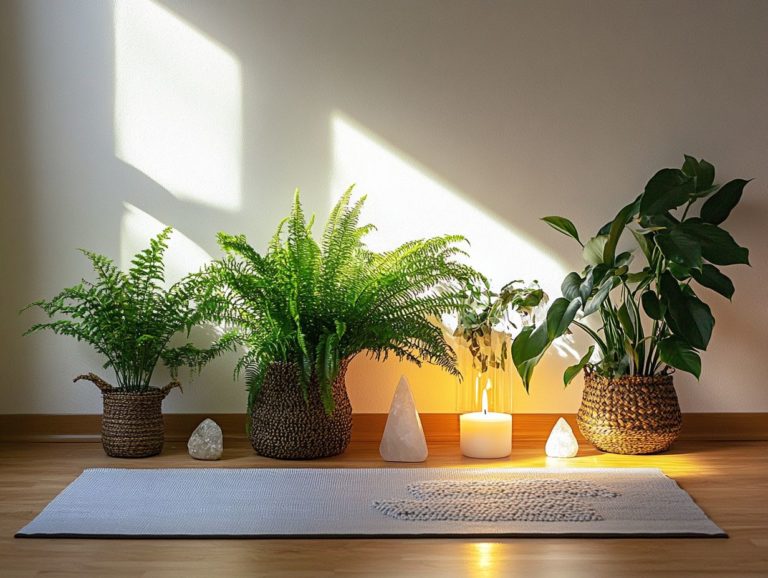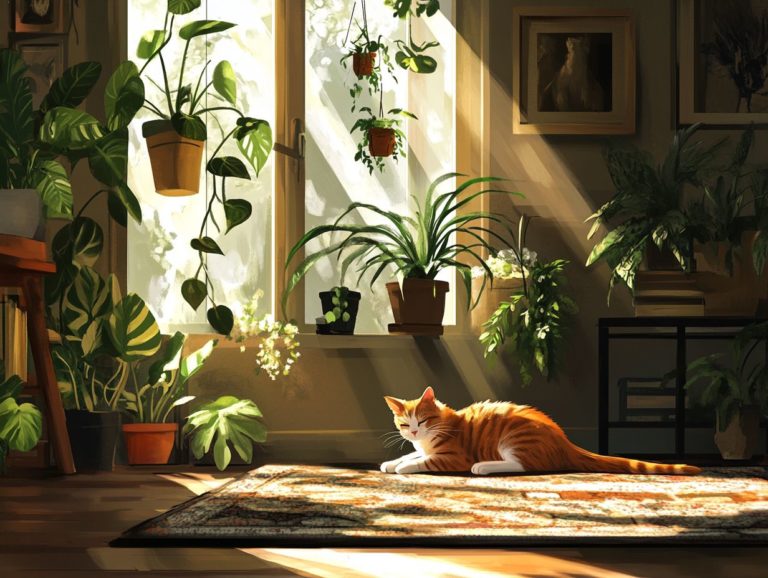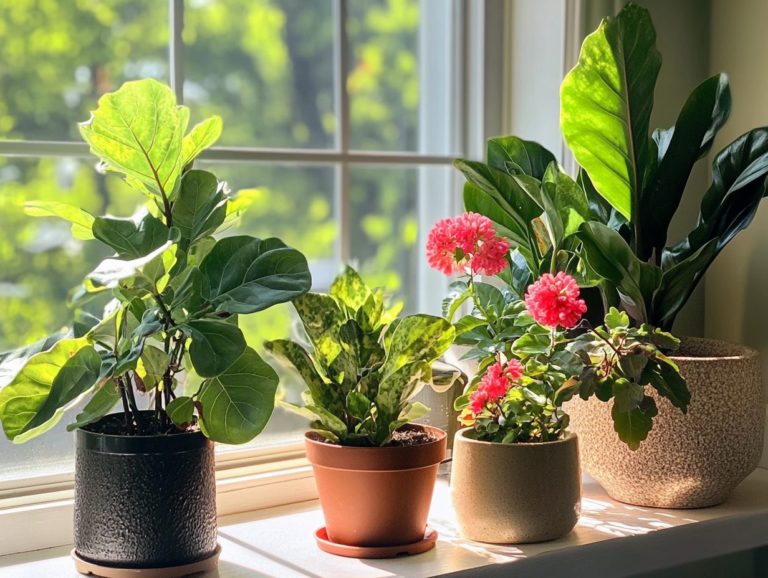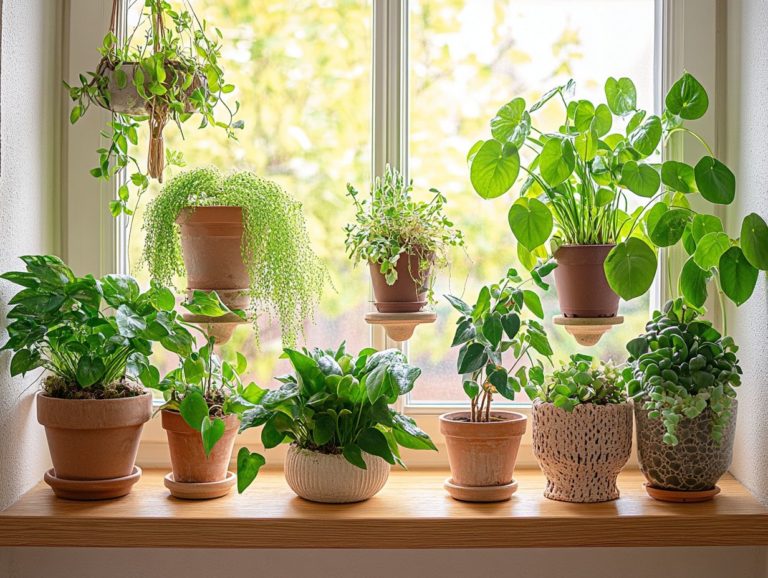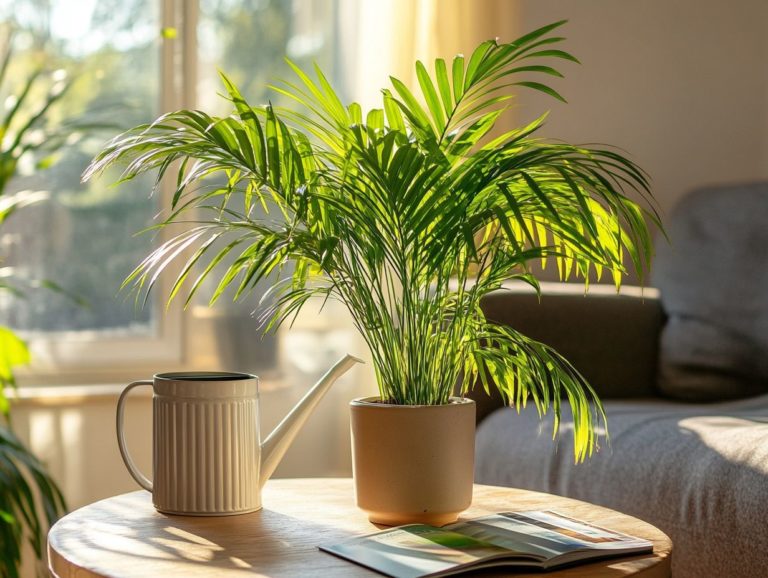Aloe Vera: Uses and Care Tips Indoors
Aloe Vera is more than just a pretty plant. It s a remarkable source of health benefits and practical uses.
Growing this succulent indoors enhances your living space and provides natural remedies.
Learn how to nurture Aloe Vera with the right lighting and watering techniques, and how to spot common pests.
Discover how to harvest its soothing gel effectively.
Ready to grow your own Aloe Vera? Let’s get started!
Contents
Key Takeaways:

- Grow Aloe Vera indoors for easy access to its health benefits, like soothing skin irritations and purifying the air.
- Provide the right lighting and watering to ensure healthy growth and prevent pests.
- Harvest Aloe Vera gel by following simple steps and maximize plant growth with care tips.
What is Aloe Vera?
Aloe Vera is a succulent plant known scientifically as Aloe barbadensis miller. It’s famous for its thick, fleshy leaves filled with a beneficial gel.
This plant thrives in warm climates and is perfect for indoor spaces. It not only looks good but also helps retain moisture and soothe the skin.
Aloe Vera is a perennial, meaning it can live for several years. Its gel is great for treating sunburns and cleaning the air in your home.
This plant offers health benefits, like aiding digestion and supporting your immune system. Its easy care makes it a great choice for anyone wanting to add greenery to their environment.
Benefits of Growing Aloe Vera Indoors
Growing Aloe Vera indoors elevates your living space and well-being. This succulent is a favorite for homes and offices.
It purifies the air, enhancing indoor air quality, and retains moisture, acting as a natural moisturizer. The gel from Aloe Vera leaves soothes skin irritations and is widely used in health and beauty products.
Aloe Vera juice is celebrated for its nutritional benefits, making this plant a true treasure for your home.
Health and Practical Uses
Aloe Vera gel is a staple in many homes, praised for its health benefits and versatility. Whether you re treating sunburns or minor burns, this gel is a gentle natural moisturizer that delivers effective relief.
Aloe Vera juice is known for its digestive benefits, helping detoxify your body and promote wellness. It s a key player in holistic health.
With anti-inflammatory properties, Aloe Vera reduces redness and irritation, making it popular for skin conditions like eczema and psoriasis. Including Aloe Vera in your skincare routine can boost hydration and elasticity for a youthful glow.
Many also enjoy Aloe Vera juice for its immune-boosting and metabolism-enhancing qualities. Whether consumed or applied, this extraordinary plant continues to be celebrated in health and beauty communities.
How to Care for Aloe Vera Plants Indoors
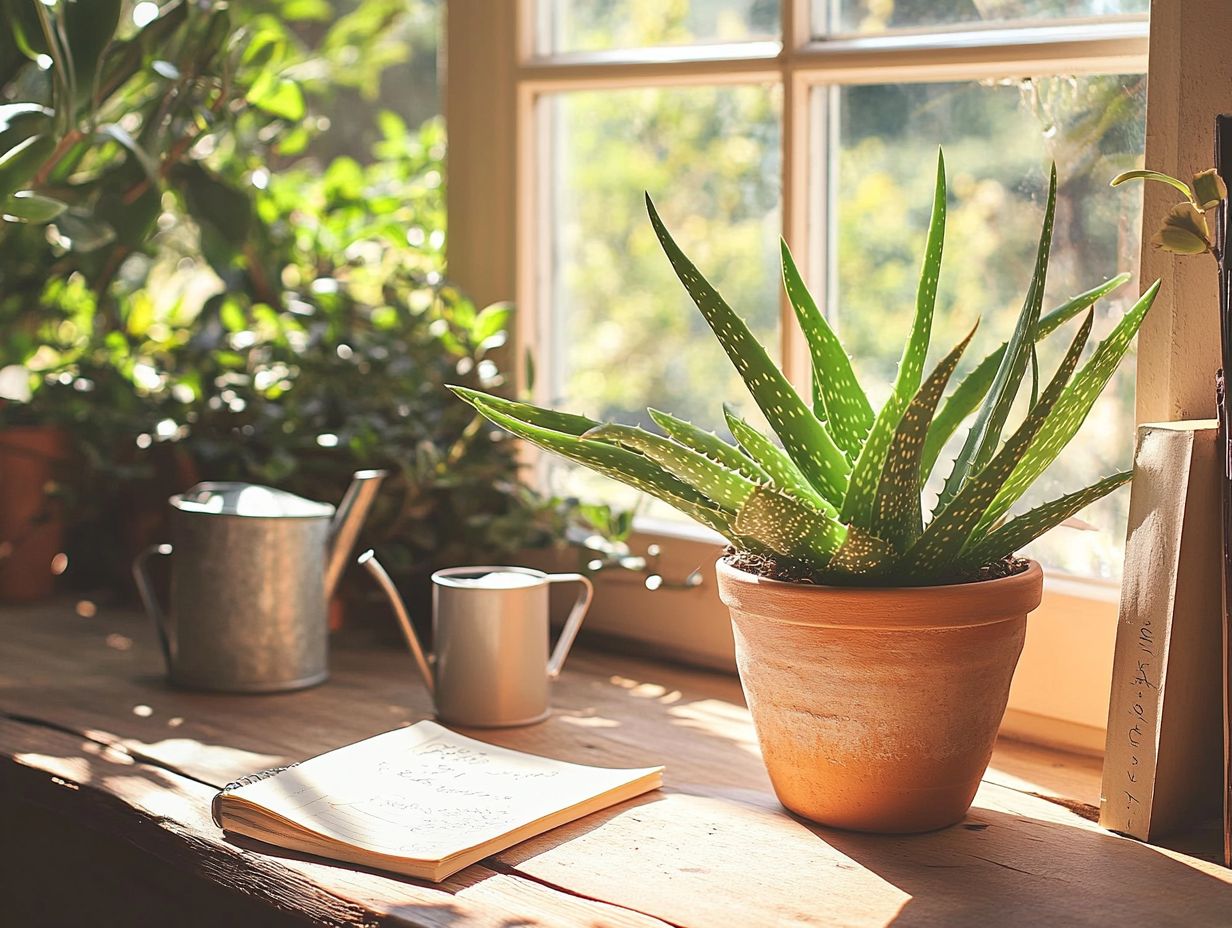
Caring for Aloe Vera plants indoors is a delightful endeavor. Grasping their specific needs is crucial for preserving their health and vitality.
These resilient succulents flourish in a well-draining soil mix that offers ample aeration. This effectively guards against the dreaded root rot that can arise from overwatering. It’s best to water your Aloe Vera only when the soil is completely dry, allowing it to thrive without undue stress.
Consider repotting every couple of years to refresh the soil and provide room for growth. This ensures your plants remain lush and vibrant through every season.
Lighting and Watering Requirements
Aloe Vera plants thrive when you provide them with bright light. Ideally, place them near a window that offers a perfect blend of direct sunlight and indirect light exposure. This setup encourages healthy leaf growth while minimizing the risk of sunburn.
It’s essential to keep a close eye on the water levels, as overwatering can lead to root rot an all-too-common issue for succulent plants. By striking the right balance of light and water, you can keep your Aloe Vera vibrant and healthy, making it an excellent choice for indoor gardening.
Set your Aloe up for success by placing it where it can soak up around six hours of indirect sunlight each day, such as by a north or east-facing window. During the summer, be mindful of the shifting angles of sunlight to avoid scorching those lovely leaves.
In terms of watering, wait until the top inch of soil has completely dried out before adding more water. This helps ensure the roots have a chance to breathe between watering sessions. Following these steps will help your Aloe flourish, showcasing its resilient nature while minimizing any water-related concerns.
Common Pests and Diseases to Watch Out For
Despite its resilience, Aloe Vera can still face some common challenges, such as pests like Aloe scale and mealybugs, which can impede its growth and damage its otherwise healthy leaves. For effective mealybug treatment, consider natural remedies like neem oil, which can eliminate these pests while preserving the plant’s integrity.
It’s essential to keep an eye out for signs of root rot, as improper watering practices can lead to this issue. This underscores the importance of preventative measures in nurturing a thriving Aloe Vera plant.
Awareness of these common pests is paramount for any Aloe Vera enthusiast. For instance, if you notice tiny, sticky residues, it may indicate a lurking aphid or scale problem, while white, cotton-like clusters often point to a mealybug invasion. Regularly inspecting your plant allows for early detection, making it easier to implement the right treatments.
Beyond natural remedies, practicing proper potting techniques and ensuring adequate drainage can significantly diminish the risk of root rot. By integrating these strategies, you’ll create a healthier environment, allowing your Aloe Vera plant to flourish and remain resilient against these common challenges.
Harvesting and Using Aloe Vera Gel
Harvesting Aloe Vera gel is an elegant process, granting you access to the numerous health benefits and practical applications this extraordinary substance provides.
To extract the gel, begin by gently cutting a mature leaf from the base of the Aloe Vera plant. Ensure that you leave behind healthy leaves for sustained growth. Once you’ve sliced open the leaf, scoop out the translucent gel. This gel can be applied directly to your skin for soothing relief or blended into your homemade beauty products and remedies.
This makes it a truly versatile asset for any health-conscious household.
Start caring for your Aloe Vera today and enjoy its many benefits!
Step-by-Step Guide
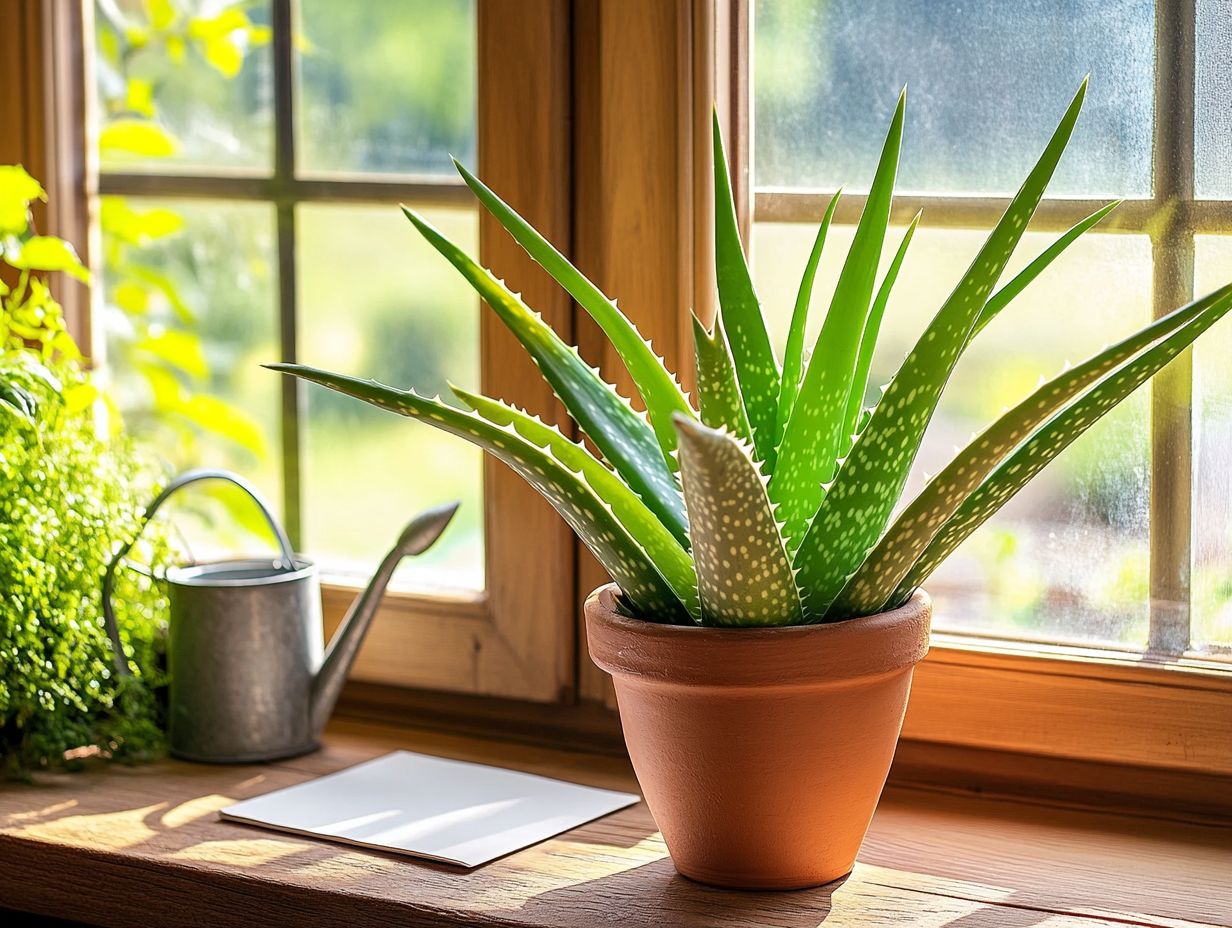
To effectively harvest Aloe Vera gel, follow this comprehensive guide that ensures both the safe extraction of the gel and the health of the plant’s remaining leaves.
This method not only maximizes your gel yield but also fosters ongoing growth and vitality in your Aloe Vera plant. Start by examining the plant for the largest and most mature leaves these are typically found on the outer edges.
Once you’ve identified the best candidates, approach the cutting process with care. Ensure your sharp knife is sanitized to prevent any bacterial intrusion.
As you slice, keep a steady hand to minimize potential injury to the surrounding foliage. After extracting the gel, remember to apply a thin layer of honey or a light ointment to the cut area of the leaf. This simple step will help protect it from environmental stressors while promoting healing.
Keep your plant happy and healthy with regular watering and plenty of sunlight!
Tips for Maximizing Aloe Vera Plant Growth
To truly maximize the growth of your Aloe Vera plants, focus on several key factors, including temperature, humidity, and specific care techniques that cater to this succulent’s unique requirements.
Aloe Vera (Aloe barbadensis miller) flourishes in a warm environment, ideally between 60 F and 75 F, with temperature and humidity levels kept relatively low to mimic its natural desert habitat. Using the right soil mix will enhance the plant’s health. This mix should drain well, often with sand or small rocks, and indoor plant care tips such as repotting your Aloe at the appropriate times will greatly improve its vitality.
Additional Care and Maintenance Tips
Along with basic care, incorporating additional maintenance tips can significantly enhance the health and longevity of your Aloe Vera plants.
Understanding soil composition is crucial. A well-draining soil mix, ideally featuring sand or perlite, will help prevent water accumulation that can harm the roots. Pay attention to humidity levels as well Aloe Vera thrives in drier conditions, and excessive moisture can be detrimental.
In terms of watering, adopt a schedule where the soil dries out completely between sessions to encourage strong roots and avoid root rot. For those specifically caring for indoor bougainvillea, tips on care can be invaluable. Regularly monitoring for pests, such as aloe scale and mealybugs, is essential. Early detection can save your plant from unnecessary stress, ensuring it remains a healthy and vibrant addition to your indoor space.
Frequently Asked Questions
-
Why should you keep Aloe Vera in your home?
Aloe Vera has various uses, including being an air-purifying plant and a natural healer for sunburns and skin irritations. It is also a low-maintenance houseplant.
-
How do I care for my Aloe Vera plant indoors?
Aloe Vera requires bright, indirect light and well-draining soil. Water deeply but infrequently, allowing the soil to dry out completely before watering again. Avoid overwatering or leaving the plant in standing water.
-
Can I use Aloe Vera for medicinal purposes?
Yes, Aloe Vera has been used for centuries for its medicinal properties. The gel inside the leaves can be extracted and used to treat burns, cuts, sunburn, and even minor skin conditions like acne while serving as a moisturizer.
-
Can I use Aloe Vera for cooking?
While Aloe Vera is not commonly used for cooking, the gel inside the leaves (Aloe gel) can be added to smoothies, juices, and even sauces for a nutritional boost. However, it is important to note that the outer skin of the plant is not edible and can cause digestive issues if consumed.
-
How often should I fertilize my Aloe Vera plant?
Aloe Vera plants do not require frequent fertilizing, as too many nutrients can harm the plant. Fertilize once every 3-4 months during the growing season with a balanced fertilizer diluted to half strength to encourage healthy aloe pups.
Is Aloe Vera Toxic to Pets?
Aloe Vera can cause vomiting and diarrhea in cats and dogs if ingested. Keep Aloe Vera plants out of reach of your pets to avoid any stomach problems.
It’s important to safeguard your furry friends. Always check if a plant is safe before bringing it home!

